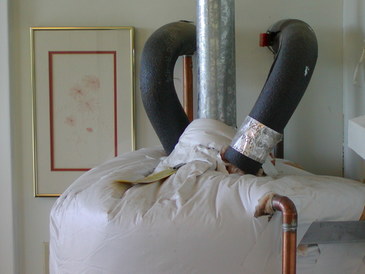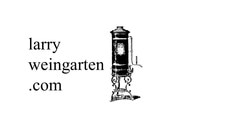 A heater blanketed a bit too much! A heater blanketed a bit too much! A plumber’s perspective on water heating technology and its implementation. I met Armin Rudd at the Hot Water Forum in Berkeley. He was giving a talk on combined domestic hot water (DHW) and space heating systems he’s been working with. One puzzling and persistent problem he found has been this bluish grey goo clogging up filters in the system. As a plumber who likes hot water, I told him it was corrosion product from an aluminum anode and he looked a bit stunned. Having been involved with plumbing since I was fourteen, I’ve been forced to become a fan of elegant simplicity. In the field, things go wrong. The more complex the equipment or its installation, the greater the likelihood of problems. The greater the technical demands on the installer or end user, the bigger chances are of details gone missing or maintenance forgotten. Combining DHW and space heating creates opportunity to build amazingly complex systems that almost beg for a spare bedroom near the equipment room, so the technician is always close at hand. The real challenge is to make things mechanically simple and comprehensible. Despite the existence of trade schools and many other resources for educating trades-people, most of the training we get in the US is on the job. Our bosses and co-workers share what they know and by making mistakes, we learn what not to do. There is little room in this scenario for the science in books to filter into the plumber’s work, but lots of room for old plumber’s tales. So, it becomes a protective thing plumbers do when they avoid new technology, because personal experience is what they rely on rather than science or other’s research to feel comfortable installing and guaranteeing equipment and systems. Those are only two of the roadblocks to making our use of hot water more efficient and sustainable. But they’re big ones and can be broken down by bringing education and science to the field and at the same time bringing field experience to the lab. I try to do what’s best for the end user as most plumbers do, and want things to be simple and easily understandable. I try for lowest life-cycle cost, even if it’s not the very most energy efficient. I want comfort for the user, because if it’s not comfortable, the system won’t live a long and fruitful life. Comfort has various faces. It means a comfortable and quiet home, an adequate hot water supply, little waiting for hot water, little time spent fiddling with the system or waiting for the technician, predictability and not too many dollars spent. Putting all of the above together is what I’ll aim to do. So I’ll begin with the obvious, but sometimes forgotten detail that if we really want efficient housing, we need to look first at the building shell. Shell work can be durable and effective, though I’m still waiting for insulation to be sexy. A good shell adds to user comfort and then allows us to look at technologies like combined space and DHW systems that don’t need to pour out enough heat to warm the entire block. As homes get snug, we find the DHW load exceeds the space heating load, both instant and yearly. For example, filling a bathtub can take a lot of energy, quickly, but heating an efficient home simply doesn’t have that big energy demand; which leads to using one heat source for both and sizing it for DHW loads. Of course, that’s a water heater! I put shell efficiency first because it’s really the low hanging fruit. Also in that category is plumbing distribution. Jim Lutz, formerly of Lawrence Berkeley Labs has been measuring plumbing system efficiency and sadly, it’s not good. A really efficient shower event delivers 80% of the energy and water that went into the system as usable hot water at the shower head. A bad shower may be 20% efficient. So, install the sort of plumbing distribution Gary Klein has been talking about that can deliver hot water anywhere in the house wasting only one or two cups, (demand plumbing or central core plumbing) and you’ll get to install a smaller water heater! So far so good. By making the shell of the house and plumbing system efficient, we’ve been able to significantly downsize water heating equipment. That equipment can be many thing such as electric or gas tank type or tankless heater; electric heat pump or in the near future we hope, gas fired heat pump. Solar or heat recovery can reduce the demand further. The concept of simple solar has hardly been looked at or explored seriously for commercialization by anybody I know other than Steve Baer of Zomeworks in New Mexico. http://zomeworks.com . As an example of what can be done, I built an efficient off grid house that’s heated by solar hot water and a wood stove as back-up. It uses a gravity driven radiant system in the walls. Its claim to fame is the ability to keep the house at 70 degrees with 80 degree water. So, if solar weren’t involved, I could use condensing technology and keep it running in its sweet and most efficient spot. Low grade heat distribution is a natural for condensing technology. It’s not hard to do with hydronic distribution, but harder with air. Did you hear the challenge? Having been in hot water for years, I’ve seen a range of equipment subjected to a variety of waters and conditions. Hard water is tough on anything that has high heat flux rates. Acidic water loves to dissolve copper. Dissimilar metals have trouble together in conductive or over-softened water. Not planning for temperature extremes will burst the odd pipe or solar panel tubing. Leaving the plumber’s apprentice alone too long on the job might not be cost effective! Let’s think about corrosion for a bit. One thing in plumbing you want to corrode is the sacrificial anode in tank type heaters. But thinking it through, metals, as they corrode produce a quantity of corrosion product that is bigger than the original metal. Our experience is that aluminum creates far more than other common metals. Where is all that going to wind up in your system? Magnesium anodes produce less stuff and are not considered unhealthy. So, knowing there will be anode corrosion product and possibly hard water scale and maybe some sand in the bottom of the tank, doesn’t it make sense never to pull water from the bottom of that tank? In the past some manufacturers have done just that and even mixed in brass fittings just to make sure the steel tank rusted to protect the brass. This makes an unwanted rust blockage where the brass screws into the tank. If the anode is doing its job, it will plate out the brass with mineral from the water and block flow there too. So, one bad connection in the wrong place can have three forces working at it to cause trouble. Perhaps the most common plumber’s tale is that brass or bronze nipples are better in steel tanks than copper. I think it implies the wrong question and sadly, it’s true, but only by a very little bit. These three metals are all in a group, a ways away from steel on the galvanic scale, thus they all have similar desire to make steel rust to protect them. Better is always to use a lined steel nipple in the tank to put distance between different metals, greatly reducing galvanic corrosion. Plumbers tale number two is that dielectric unions work. A dielectric is usually brass and steel separated by a thin rubber washer, in water. It’s also the only place in a modern potable system where steel is encouraged to be wet. Typically the steel rusts, bridging the rubber washer and eventually the dielectric turns into a seeping, rust filled, flow restricting bump in the line. Using a lined nipple with a flex connector that has a true dielectric in it will give good separation of metals without the problems. This brings up the concern of stray current corrosion. Anything that blocks electrical current flow in plumbing forces that current to jump off the pipe, swim through the water and land further down the line back on the metallic pipe. The point where current leaves the line will disintegrate. This does make one want to use dielectrics only where absolutely needed. It also promotes jumpering and grounding systems to give the current an easier path to take to get back to earth. Normally, using #6 solid copper wire between hot and cold over a heater and then running that to the ground bar at the main electric panel is good. Single point grounding prevents trying to force current through the earth and building up differences in voltage between grounds. All this only means you keep any current from flowing through the plumbing and equipment, which is good. Stray current comes from at least three sources. It used to be common practice to ground the electrical system to metal plumbing. Should any appliance have internal electrical leaks, it would energize the plumbing a bit. Meter repairers have been electrocuted by removing a water meter without jumpering between the two pipes first. I’ve often found leaks in electric heaters where the heating element sheath splits or corrodes, letting water into the element and electricity out. This is easy to test for with a volt ohm meter in the ohms setting. Another source of current in metal lines is simply wiring running close by. It acts as a crude transformer, inducing current in the plumbing. If a known good ground can be brought to suspect plumbing one can test for voltage between the ground and pipe. An extension cord and meter are all that’s needed. It’s common in my area that the main steel supply line to a home gets replaced with PVC. If plumbing was used as a ground path, now it doesn’t work anymore and current will be forced to find new routes. Tying existing plumbing into the main panel’s ground when the water supply is replaced makes sense, but isn’t always done. It turns into a “that’s not my job” moment. A third source of current would be nearby lightning. During a lightning storm might not be a good time to be fooling around looking for leaks to ground or golfing. About 85% of the US has hard water. That is a concern when trying to get heat quickly into water. I’m lucky in a way that my little corner of the world has water than varies from 40 to over 800 parts per million of total dissolved solids. I used to embarrass my wife by carrying around a total dissolved solids (TDS) pen and checking water at restaurants. A lot of water softening is done where I live. When water is over-softened, tank type heaters live short lives and no protective scale can build up inside copper pipes, leaving them to erode over time. The National Association of Corrosion Engineers suggests leaving 60-120 ppm of TDS in the water after softening. Softener people prefer softening down to zero. Odor problems happen much more often with softened water and with tanks that are too big for the usage they get. Tankless heaters don’t like hard water, we learn from their warranties. In boilers, even a little scale has a dramatic effect on performance. I have not seen a study on the effects of scale on modern tankless heaters, but hope to, because it would let tankless users know whether performance falls off or not with hardness and also help them to know when de-scaling should be done. Hardness makes things that move inside the plumbing not move so well. Re-circulation lines often have swing check valves that lime up in the open position. Pumps get jammed when scale finds its way into them. Tempering valves all fail. Then there are relief valves. I like to test relief valves on tanks because I don’t want any heater I’ve seen to make the evening news by blowing up. One quarter of the valves I test don’t work for some reason. Of those, about one in ten will not let water through. They are plugged solid with minerals. This happens even when they sit up on top of the heater. I can only guess the anode wants to protect the brass and plates it out with hardness from the water. Still, if one of forty heaters has no protection, we must be relying on good controls to keep heaters on the ground. The problems of hard water can be reduced with appropriate use of materials; not just a well managed softener, but PEX piping, valve stems that don’t de-zincify and provisions for easily flushing any part of the system that could ever need it. Homes will continue to get more efficient. As they do, combined systems will make better and better sense. We’ll probably need to come up with several system types for different climates, water quality concerns and budgets. Looking at distribution for a moment, I think it useful to consider both air and water as our friends for moving BTUs around. I read that a ½” pipe can carry as many BTU’s as an 8” duct, using about 1/50th as much energy to move them. This suggests simple heating systems could work nicely right now. Just as shell tightening can have a huge effect on the load, it might be useful to look around the house to see where other sources of heat could come from. We may, someday want to intentionally capture or vent out the heat off the back of the fridge, do something useful with attic heat, or see if earth tubes can be designed that stay dry and work as designed. Even though I’m away from the coast where I live in California, cooling is seldom needed. We do have fairly dry air, so even if cooling were needed, I could use chilled water with little risk of condensation. Where high humidity is the norm, chilled air might be a better medium for moving coolth around. Linda Wigington formerly of Affordable Comfort is working on the Thousand Home Challenge, http://thousandhomechallenge.com which sets the bar high for reducing home energy use. The people who are on the path for this challenge make a natural testing ground for ideas any of you may have for what makes a good combined system. Linda is creating categories for system types by region and housing type and I’m certain would welcome your involvement. Although I’ve mentioned a number of technical considerations for combined systems, the biggest difficulties lie with plumber and end user education and expectations. Keeping a plumber on tap somewhere near the design lab couldn’t hurt either. Unless those needs are dealt with, getting good systems installed will remain the exception. Yours, Larry
0 Comments
Leave a Reply. |
Larry Weingarten
Looking back over my working life of 50+ years, it seems clear that self sufficiency has always been the best way for me to be useful. Now, mix in a strong interest in water in its many forms and the wide world of animals and you'll know what's important to me. Archives
January 2023
Categories |
Copyright © 2014 - 2023
All Rights Reserved
All Rights Reserved



 RSS Feed
RSS Feed